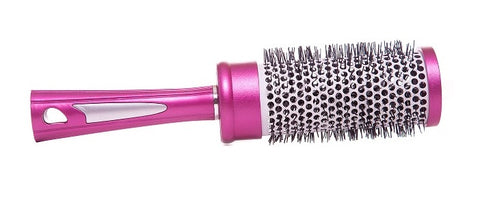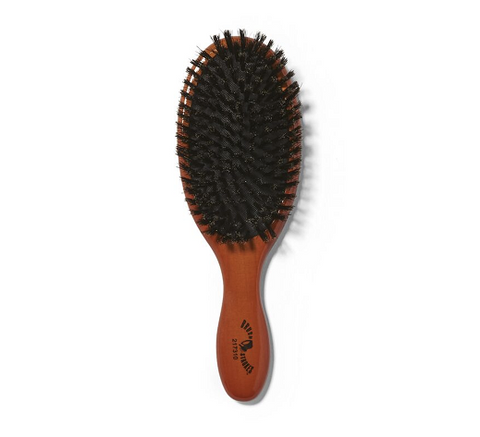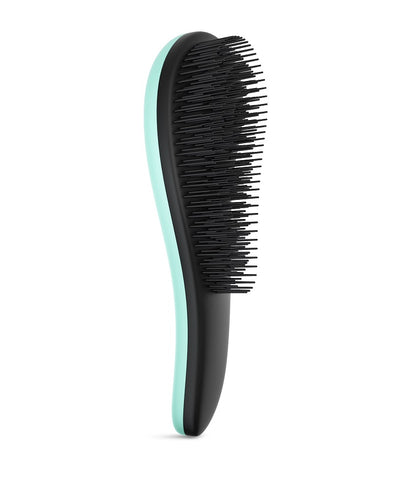The Best of the Detangling Brush: Your Guide to a Pain-Free Detangle

TYPES OF HAIRBRUSHES
The world of hairbrushes can be a little confusing, and a whole lot distressing (especially when you pick the wrong kind). But, knowing the difference between your brush options is the first step to understanding which brush will give you the most gentle experience. And while it may not seem like it, there’s a method to the hairbrush madness. At your service, the most common brushes on today’s market:



The Detangling Brush

But, how exactly do detangling brushes work?
And… why are detangling brushes so good for your hair?
If you or your child cries every time you have to handle your/their hair, then you haven’t found the right detangling brush. Detangler brushes are specifically designed to glide through your hair smoothly and without causing pain. Nobody likes the pain that comes with yanking and tugging to ease knots.
Easy to Use
Most detangling brushes are easy to use. Some have straight handles like ordinary brushes, while some are designed with ergonomic handles which make it more comfortable to handle and easy to glide through tangled hair. Therefore, the process of detangling becomes fast, easy and painless.
Versatile
Getting the right type of brush can speed up the process of detangling, especially when you need to be able to use it on wet or dry hair. You can also use detangling brushes on your wigs and extensions with minimal breakage and damage.
Gentle
Bristles on detangling brushes are designed to reduce the pressure and tension on your scalp and hair. In this way, you can reduce damage, hair breakage and splitting of the hair. The detangler brush works efficiently, so you’ll need fewer strokes to remove all the tangles, especially if you follow the right detangling approach.
So which is the best detangling brush for YOU?
Given that the detangler brush works through knots and tangles, you want firm bristles that won’t lose shape.
Cone-shaped, Plastic Bristles
Avoid ordinary bristles which work against the hair grain; you want cone-shaped, smooth, plastic bristles which gently make their way between hair strands coaxing them to come apart.
Varying Bristle Length
When a detangler brush has varying bristle lengths, it works to separate hair instead of pulling it down, which makes detangling hair much more easier.
Bead vs Beadless Bristles
You don’t want a brush that digs into your scalp or gets caught in your strands because of rough edges that happen when beads fall off the bristles. When this happens, the metal or plastic bristles beneath the bead can scrape your scalp.
Good for Wet or Dry Hair
The brush should glide through your wet or dry hair with ease, leaving a great feeling on your scalp. This increase in circulation can actually stimulate further hair growth.
With a good detangling brush by your side, you won’t cringe or panic when it comes for wash day. Instead, you’ll slide into your normal routine and wind up with a long brushing session that leaves your hair detangled, light and beautiful.
What are the desirable qualities of detangling brushes?
Wet vs. Dry Detangler Brush
You care about whether your hair is wet or dry when detangling because wet hair is fragile hair. You need a gentle brush with bristles spread apart, as it can be used on both wet and dry hair. Damp hair is still fragile, but it is softer, hence easier to detangle. Be sure to get an all-round brush.
Natural detangling brush bristles are commonly made from boar bristles, and they’re good for helping to redistribute oils within your hair strands. However, most boar bristle brushes come in clumps of individual bristles instead of singular bristles. This makes the process more time consuming, and you must be more patient with your hair to avoid breakage.
Synthetic bristles will either be metallic or plastic. Metallic bristles are naturally stiff, which makes them ideal for detangling, but they can be uncomfortable to use, especially when you’re in a hurry.
Plastic bristles make the best detangling brush for fast detangling. Provided they’re stiff and spaced apart, you’ll get the same detangling results without the discomfort of metal. You’ll also enjoy the scalp massage with plastic bristles.
Paddle Design Detangler Brush
The paddle style is the most common style on a detangler brush – featuring a large rectangular or oval head with a handle of varying length. The handle is usually padded to give better grip and comfort when using. When getting your paddle brush, be sure to check the bristle density – you’ll find dense and sparse bristle placements made from both metal and plastic.
Always choose wide-spaced bristles for detangling, and denser bristles for styling. Extension or wig brushes are often great for detangling too.
Rounded Tips
Manufacturers have invested in different features to make their brushes stand out from others on the shelves – great news for the customer! For instance, most detangler brushes will have rounded tips. You want rounded tips because sharp bristles can rip out loose hairs in the process of detangling. Rounded tips aren’t the same as beaded tips, which aren’t desirable in a detangling brush.
How Do You Detangle Matted Hair?
There are people whose hair strands have weak cuticles, while others have longer, curly, coily or kinky hair. Because of the length or curling, such people become more prone to matting than people with naturally straight hair.
If you have matted hair, you don’t have to cut it out; you can patiently detangle it if you have the right brush and the right products. You’ll also need a lot of time and patience because you’ll have to be extra gentle taking out the tangles without damaging the hair that is attached. To detangle it successfully, follow these steps:
1. Dampen Your Hair
Use a spray bottle to make your hair damp, or briefly hold under a tap or shower at low water pressure. You don’t want the hair to be dripping wet, because it is more fragile when wet.
2. Add Product
Never use shampoo only on matted hair; use a good detangler, oil or conditioner to saturate your hair. Deep conditioning is helpful for restoring moisture and repairing weak cuticles, to make tangles easier to come apart. Detangling conditioners add slip to the strands so that they separate easier.
You can also use oils like Moroccan Argan, coconut, or olive oil, or a detangling spray. You’ll need to leave the product on for some time – oils need 30 minutes, while conditioners need a few minutes – according to the instructions on the package.
3. Finger-Comb
Gently pull apart the tangled sections of your hair using your fingers. You’ll notice larger tangles separating into smaller tangles closer to your hair root.
4. Brush with Detangling Brush
Once you have the large tangles cleared, it’s time to bring out your detangling brush. Handle your hair gently in sections. Start near the ends and comb out all the way to the ends, once the ends are clear, move further up towards the hair root, each time working the tangles all the way to the ends. Never start detangling from the root. Repeat until the whole length is combed, and then move to the next section.
If your scalp is painful, hold on to the section and pull towards the root as you brush towards the ends. This will prevent from pulling at the scalp and causing pain. Do this for a child also.
5. Rinse
Once the brush moves easily throughout your hair, rinse out the product. Be careful not to tangle the hair as you rinse, and then add a leave-in conditioner to preserve softness and some light oil to seal before styling.
Do detangling brushes work on Curly or Coily Hair?
Handling kinky, coily or curly hair gives an extra challenge when you’re detangling because the curliness increases the likelihood of knotting and tangling. To keep your mane detangled and healthy, be sure to patiently and extensively detangle your hair after every wash.
It becomes even more critical to have a high-quality brush with firm bristles that are widely spaced, otherwise you may trigger more than the necessary hair fall while handling your hair. Once you have the right tool by your side, all you need is patience and gentleness to bring out your hair’s natural glory.
IN CONCLUSION
Having a good quality detangler brush is critical in your journey of hair care. Luckily, a good quality brush will last years and years before needing replacement, and you’ll go back to enjoying your hair maintenance days instead of dreading them. Follow our guidelines to get yourself a detangling brush that works for you and your hair.




